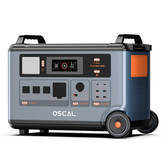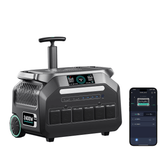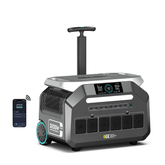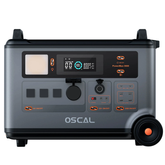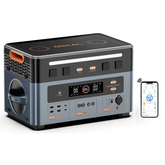How Do Solar Generators Work?
how do solar generators work — it’s a question more and more Europeans are asking as renewable, silent, and portable energy becomes mainstream. From rooftop setups in Germany to van-life rigs in Spain and weekend campsites in Sweden, understanding how solar generators work helps you choose the right system for travel, home backup, or off-grid life. This guide uses the IEE P2400 as a running example to explain components, charging methods, efficiency, safety, and real-world EU use cases.
Solar generators combine photovoltaic input, charge regulation, battery storage, and inverter output to deliver clean AC power. But there’s more to it than simple plug-and-play — knowing the details will help you size panels, extend battery life, and get reliable performance across Europe’s varied climates.
What Is a Solar Generator?
A solar generator is a portable power system that converts sunlight into electrical energy, stores it, and provides usable AC and DC outputs. Unlike conventional petrol generators, solar generators are quiet, emission-free, and safe for indoor environments. They are ideal for EU households wanting backup power, campers seeking sustainable energy, and professionals needing portable electricity on-site.
Core Components: How Do Solar Generators Work Internally
To answer how do solar generators work, we need to break the system into its four essential parts:
1. Solar Panels (Input)
Solar panels contain photovoltaic (PV) cells that turn sunlight into direct current (DC). Panel output varies by wattage, angle, temperature, and irradiance. For the IEE P2400, pairing with panels in the 200W–400W range per panel is common; combining two or three panels can supply substantial charging power even in moderate European sunlight.
2. Charge Controller (MPPT or PWM)
The charge controller manages the flow from panels to battery. Modern systems use MPPT (Maximum Power Point Tracking) controllers that extract up to 30% more power than older PWM controllers, especially useful in the cloudy and variable light conditions found in much of Europe. The IEE P2400 includes MPPT support to optimise charging throughout the day.
3. Battery (Energy Storage)
Batteries store energy for later use. Two common chemistries are used:
- LiFePO₄ (LFP) — long cycle life (2,000–5,000+ cycles), excellent thermal stability, and high safety. Favoured for heavy-duty and home backup systems.
- NMC / Lithium-ion — higher energy density, lighter, used in portable, weight-sensitive units.
The IEE P2400 uses LiFePO₄ cells for long life and safety — an attractive feature for European households and mobile users who expect longevity and indoor-safety.
4. Inverter (DC to AC)
Most EU appliances require AC at 230V. The inverter converts DC from the battery to clean AC power. Pure sine wave inverters are recommended for sensitive electronics and efficient motor-driven devices. Units like the IEE P2400 typically use pure sine wave inverters to ensure compatibility with laptops, kettles (short bursts), fridges, and power tools.
Step-by-Step: How Do Solar Generators Work in Practice?
- Sunlight hits solar panels — PV cells produce DC electricity.
- Charge controller optimises input — MPPT maximises power under changing light.
- Battery stores energy — energy is buffered for immediate or later use.
- Inverter converts DC to AC — your devices can be powered at 230V.
- Outputs Are Used — AC sockets, USB ports, and DC outputs feed your devices.
Why Solar Generators Are Gaining Traction in the EU
Several Europe-specific factors fuel adoption:
- Rising electricity prices make off-grid supplement systems financially sensible.
- Green policies and incentives favour renewable, low-emission tech.
- Vanlife and outdoor culture — mobile solar setups enable comfort without fossil fuels.
- Grid instability in rural regions increases demand for reliable backup power.
- Indoor safety — no fumes or noise, ideal for apartments and holiday homes.
Real-World Use Cases: How Do Solar Generators Work for EU Users?
Home Backup
For power outages, a solar generator like the IEE P2400 can sustain:
- Wi-Fi / router
- Lights and chargers
- Fridge (short duty cycles)
- Small medical devices (CPAP)
With AC + solar charging, you can keep essentials running for hours to days depending on battery size and solar input.
Camping & Outdoor Adventures
Solar generators are perfect for tents, cabins, and remote campsites. They provide quiet, emission-free energy for lighting, small cookers, camera batteries, and portable fridges. Pair an IEE P2400 with a 400W array for robust day-to-day camping performance.
Vanlife & RV Use
Roof-mounted panels feed a portable or integrated generator, charging the battery while driving or parked. Advantages include silent operation, no fuel storage, and easy overnight use in urban or protected natural areas.
Field Work & Small Business
Market vendors, mobile technicians, and photographers often require portable, reliable power. The IEE P2400’s strong AC output and LiFePO₄ battery make it suitable for powering tools, lights, and charging stations on-site without a noisy generator.
Charging Performance: How Fast Can a Solar Generator Charge?
Charging speed depends on:
- Solar input wattage — more panel wattage = faster charge;
- Sunlight conditions — direct sun vs cloudy;
- MPPT efficiency — smarter controllers capture more energy;
- AC charging capability — many units support fast wall charging as well.
| Input Source | Typical Charge Time (example IEE P2400) |
|---|---|
| 400W Solar | 6–8 hours (full sun) |
| 600W Solar | 4–6 hours |
| 230V AC Wall (fast charge) | 1.5–2.5 hours |
| Car Charging | 8–12 hours (slow) |
Efficiency & Climate: Do Solar Generators Work in Cloudy Europe?
Yes — modern MPPT controllers and efficient PV panels allow useful charging even on overcast days. Geographical differences matter:
- Southern Europe: abundant sun, excellent yield.
- Central Europe: good output most months; winter requires realistic expectations.
- Northern Europe: shorter peak seasons, but still viable with larger panel arrays and efficient charge controllers.
Safety: Are Solar Generators Safe to Use Indoors?
Compared with fuel generators, solar generators are much safer:
- No fumes, no combustion
- Built-in BMS (Battery Management Systems) protect against overcharge, overcurrent, and overheating
- LiFePO₄ chemistry improves thermal stability and reduces fire risk
IEE P2400 includes protections like short-circuit, over-temperature, and low-temperature charging, making indoor use acceptable when following manufacturer guidance.
Practical Tips: Get the Most Out of Your Solar Generator
- Optimize panel angle — in EU latitudes, tilt panels seasonally for best yield.
- Use MPPT controllers — better harvest in variable light.
- Clean panels regularly — dust and pollen reduce efficiency.
- Avoid deep discharges — keep battery between 20%–80% for longevity when possible.
- Combine AC + solar charging when fast refill is required.
Common Questions EU Users Ask
Can I run a fridge with a solar generator?
Yes—short duty-cycle fridges are suitable. Pay attention to startup surge and continuous draw; choose units with enough surge capacity and battery reserve.
What size generator do I need for vanlife?
A balance between weight and runtime: many van lifers use 1000–3000Wh systems depending on fridge size, heater needs, and daily charging capability.
Do I need a large panel array?
Depends on use. Daytime-light users can get by with 400–800W. For multi-day off-grid or heavy loads, 1000W+ arrays shorten charge times and increase autonomy.
Cost & Longevity: Is It Worth It?
Initial costs are higher than a small petrol generator, but long-term ownership costs are lower due to no fuel, low maintenance, and long battery life (especially with LiFePO₄). For many EU households and mobile users, the environmental and practical advantages justify the investment.
Final Checklist Before Buying
- Confirm continuous AC output and surge capacity for intended appliances.
- Check battery chemistry and rated cycle life (LiFePO₄ preferred).
- Verify MPPT solar compatibility and max solar input.
- Ensure pure sine wave inverter for sensitive electronics.
- Look for EU certifications and local support options.
Conclusion: How Do Solar Generators Work?
Understanding how do solar generators work empowers European users to choose systems that fit camping, vanlife, home backup, or professional needs. By converting sunlight through PV panels, optimising input with MPPT controllers, storing energy in safe LiFePO₄ batteries, and converting to 230V AC with a pure sine inverter, solar generators like the IEE P2400 deliver reliable and clean power across EU climates. Whether you prioritise silent operation, environmental impact, or long-term savings, a correctly sized and configured solar generator is a future-proof solution for many users across Europe.

